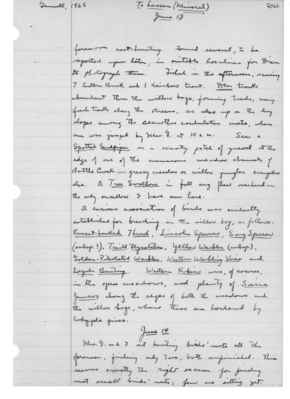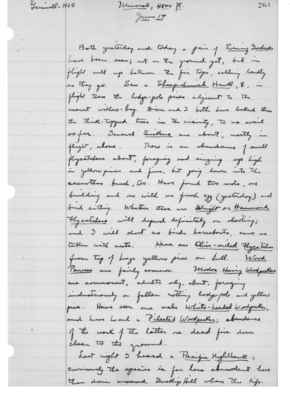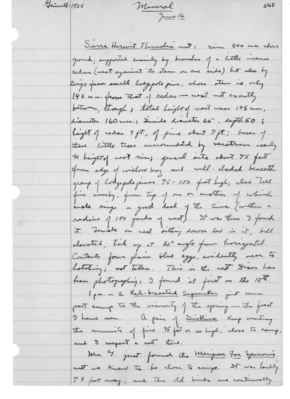Pages That Mention bog
1925: Joseph Grinnell's field notes
S2 Page 6
Collector: Grinnell - 1925 Location: Lassen Section (Mineral) Date: June 13-14, 1925 Page Number: 2462
forenoon nest-hunting. Found several, to be reported upon later, in suitable locations for Dixon to photograph them. Fished in the afternoon, securing 7 Eastern Brook and 1 Rainbow Trout. Deer tracks abundant thru the willow bogs, forming trails; many fresh tracks along the streams, as also up on the dry slopes among the Ceanothus cordulatus mats, where one was jumped by Mrs. G at 10 a.m. Saw a Spotted Sandpiper on a scanty patch of gravel at the edge of one of the numerous meadow channels of Battle Creek - grassy meadows on willow jungles everywhere else. A Tree Swallow in full song flew overhead - the only swallow I have seen here. A curious association of birds was evidently established for birding in the willow bog, as follows: Russet-backed Thrush, Lincoln Sparrow, Song Sparrow (subsp.?), Traill Flycatcher, Yellow Warbler (subsp.), Golden-Pileolated Warbler, Western Warbling Vireo and Lazuli Bunting. Western Robins were, of course, in the open meadows, and plenty of Sierra Juncos along the edges of both the meadows and the willow bogs, where these are bordered by lodgepole pines. June 14 Mrs. G. and I out hunting birds' nests all the forenoon, finding only two, both unfinished. This seems exactly the right season for finding most small birds' nests; few are sitting yet.
S2 Page 7
Collector: Grinnell - 1925 Location: Lassen Section (Mineral) Date: June 14, 1925 Page Number: 2463
Both yesterday and today a pair of Evening Grosbeaks have been seen; not on the ground yet, but in flight well up between the fir tops, calling loudly as they go. Saw a Sharp-shinned Hawk, female, in flight thru the lodge-pole pines adjacent to the nearest willow-bog. Dixon and I both have looked thru the thick-topped trees in the vicinity, to no avail so far. Several Siskins are about, mostly in flight, above. There is an abundance of small flycatchers about, foraging and singing up high in yellow pines and firs, but going down into the ceanothus bush, too. Have found two nests, one building and one with one fresh egg (yesterday) and bird sitting. Whether these are Wright or Hammond Flycatchers will depend definitely on shooting; and I will shoot no birds hereabouts, save any (?) taken with nests. Hear one Olive-sided Flycatcher from top of huge yellow pine on hill. Wood Pewees are fairly common. Modoc Hairy Woodpeckers are commonest, adults only, about, foraging industriously on fallen rotting lodge-pole and yellow pine. Have seen one male White-headed Woodpecker, and have heard a Pileated Woodpecker; abundance of the work of the latter on dead firs down clean to the ground. Last night I heard a Pacific Nighthawk; curiously this species is far less abundant here than down around Inskip Hill where the life-
S2 Page 12
Collector: Grinnell - 1925 Location: Lassen Section (Mineral) Date: June 16, 1925 Page Number: 2468
Sierra Hermit Thrushes nest: rim 800 mm above ground; supported mainly by branches of a little incense cedar (nest against its stem on one side) but also by twigs from small lodgepole pine, whose stem is only 145 mm. from that of cedar - nest not exactly between, though; total height of nest was 145 mm., diameter 160 mm.; divide diameter 65, depth 50; height of cedar 4 ft., of pine about 7 ft.; bases of these little trees surrounded by veratrum nearly to height of nest rim; general site about 75 fee from edge of willow bog and well-shaded beneath group of lodgepole pines 75-100 feet high; also tall firs nearby, from tip of one or another of which male sings a good deal of the time (within a radius of 100 yards of nest). It was thus I found it. Female on nest sitting down low in it, bill elevated, tail up at 80° angle from horizontal. Contents four plain blue eggs, evidently near to hatching; not taken. This is the nest Dixon has been photographing; I found it first on the 13th. 1 p.m. - a Red-breasted Sapsucker just came past camp to the vicinity of the spring - the first I have seen. A pair of Siskins keep visiting the summit of firs 75 feet or so high, close to camp, and I suspect a nest there. Mrs. G just found the Mariposa Fox Sparrow's nest we knew to be close to camp. It was hardly 75 feet away, and the old birds are continually
S2 Page 46
Collector: Grinnell - 1925 Location: Mineral Date: June 26 Page Number: 2500
nest found ten days ago, barely began; 3 eggs in nest day before yesterday.
6269 Wright Flycatcher [female symbol] with set 4/4 11.0 g. Had evidently had an accident by which a lot of feathers on back were lost, there being now in process of replacement. Possibly, delayed nesting due to this accident.
June 27 4 p.m. - Cassin Vireo's nest: rim 1750 mm. above ground; nest near end of drooping cedar branch, 7 feet out ^(on south side) from trunk of tree, which is 15 inches in diameter 3 feet from ground. Site about 10 yards from edge of willow bog on one side and less distance from heavy stand of firs, on the other side; lodgepole pines bordering bog close by. This nest was found partly built on the 15th, empty but seemingly completed on the 20th, now with 4 fresh or nearly fresh eggs ^(two of them) and female incubating. Taken, set 2/4. Male bird sang awhile, then went away. After I had waited 20 minute, the [female symbol] came quietly, and I "collected" her.
5 p.m. - Traill Flycatcher nest and set 1/4, taken. Nest, not quite completed, found on 20th, now four eggs, nearly or quite fresh; birds close about me. Nest in dense willow jungle. Rim only 1040 mm. above running water of creek, here entirely overgrown with matted willows. Nest on slanting stems, overtopped by fully 5 feet of lush willow growth.
S2 Page 52
Collector: Grinnell - 1925 Location: Mineral Date: June 28 Page Number: 2506
per acre. The tract in question is gently sloping toward the south; while there is no water on it, water is within easy reach, at the camp ground spring 100 yards to the east or at the first willow bog 200 yards to the south. The vegetation is mixed conifer and chaparral, the later by area predominating and consisting almost solely of ceanothus cordulatus, so greatly like by many birds because it affords safe nesting places plus (right now) an abundance of insect life. The conifers on it are chiefly firs (white), but there are also lone yellow pines, affording lofty perches, and some incense cedars.
We have seen many other birds on our plot, besides those named on the map - foragers or vagrants from adjacent ground; for example, Calif. Purple Finches, Siskins, and Evening Grosbeaks; and at night, Pacific Nighthawks. One puzzling case is that of Calliope Hummers, of which 4 males have separate distinct "stands" on our plot. The females come onto the plot to forage about the castillejas plentiful in the brush, but as far as we can judge, these females are only visitors, having there [sic] nests off somewhere, probably in the belt of lodge pole pines down along the willow-bogs, where the males do not go. One male has his "stand" one telefone [sic] wire, which crosses our plot near its southern boundary. Beneath




